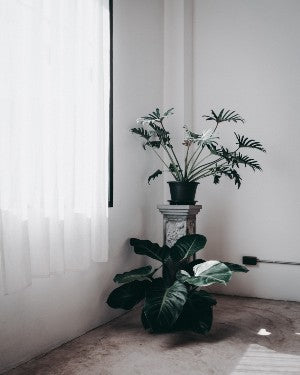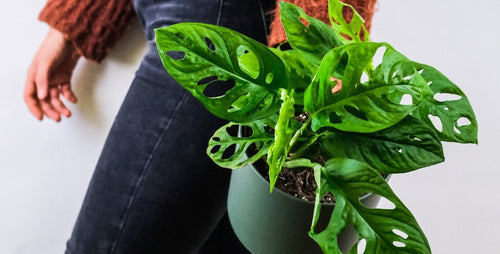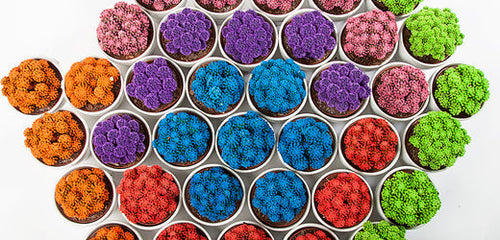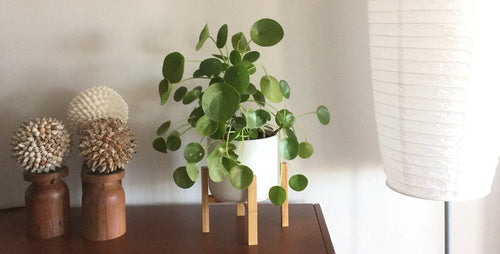By Doug Jimerson
Becoming a good plant parent is easy when you know and follow some basic guidelines to help keep your plants in great shape. Here are 10 simple things to keep in mind. Know your plant
Know your plant
No two types of plants are exactly the same. Some evolved in dry climates, others in moist regions. Some plants thrive in the heat, yet others prefer life a bit cooler.
If you select plants that match your home’s conditions (bright, dark, dry, humid, warm, cool, etc) you’ll be a more successful plant parent. So, do some research about indoor plants before you go to the garden center and get overwhelmed with all the gorgeous selections.
Water correctly
Water is essential for all living things, but too often, plant parents either over do it or forget to water at all. Either way, plants will quickly show signs of distress (interestingly, yellow leaves can signify if a plant is too dry or too wet). That’s why it’s so important to know how much water each of your plants requires. If, for example, you love succulents and cactus, they often only need a light drink once or twice a month, while more thirsty species such as peace lily and ferns may need a drink at least once a week.
Good drainage is also important for all plants. Make sure the pots your plants are growing in have drainage holes and, if they don’t, take a bit more care to not soak the soil. Watering less frequently, but more thoroughly is also a good idea. Add water until it starts to flow out of the drainage holes, then stop. This way, you know the entire root ball has been hydrated, not just the top inch or so of soil. And finally, some plants are sensitive about chlorinated water so use rain water or distilled water when you can. Or, at least allow your chlorinated water to sit overnight before using, this will allow the chlorine to dissipate into the air beforehand.  Understand lighting
Understand lighting
If plants don’t get the right amount of light they can’t make chlorophyll which is vital for photosynthesis, the process that allows plants to absorb energy from the sun. But, not all plants need the same amount of light to survive. Sun-worshippers such as crotons will sulk and fade if they don’t get enough direct sunlight, yet others like ferns will just bake if left in the sunshine. The key, as it is with water, is to know what your specific plant needs to be happy.
In general, indoor plants are listed as low light, medium light, and high light. But, what does this mean? Low light plants are those that can get by with just 2 to 4 hours of indirect light a day while medium light plants prefer at least 4 to 6 hours of indirect sun a day. High light plants need 6 to 8 hours of direct sunlight per day. Of course, if your home doesn’t provide the right amount of light for your favorite plant, you can augment natural light with artificial. Fluorescent “grow light” bulbs work well in a pinch, but they need to be hung 18 to 24 inches above your plants.
Choose quality soil
Most house plants aren’t fussy about soil type. At Costa Farms, we generally recommend using a quality, bagged potting mix designed specifically for indoor plants. Some species, especially cactus and succulents, do require a faster draining medium so look for mixes designed especially for them that have a bit more sand mixed in. Orchids are the exception because they like quick drainage, but because they naturally grow in the treetops, they prefer to grow in bark chips with no soil at all. 
Increase humidity
Some plants such as succulents and cactus thrive in dry air, but many others prefer a more humid environment that more closely mirrors their rainforest roots. Palms, dracaena, spider plant, pothos, Madagascar dragon tree, ferns, nerve plant, ivies, and ficus are just a few of the many species that love moist air. To keep them happy, it’s smart to add a humidifier to your home especially during the winter months. The air in centrally-heated homes dries out a lot when your furnace is running 24/7.
Or, you can also amplify the humidity around specific plants by setting them on an oversized, pebble-filled saucer in a reservoir of water. As the water evaporates, it will increase the humidity around your plant. Just be sure to let the plant sit on the pebbles, not directly in the water. Mainly people also like to mist their plants regularly, which is fine, but it really only provides a momentary relief from dry air and doesn’t give your plants much lasting benefit.
Inspect weekly
It’s a good idea for plant parents to inspect their leafy children at least once a week, especially during the winter. That’s when dry air can encourage pests such as scale, mealy bug, spider mite, and aphids to get a foothold. Always check the tops and bottoms of the leaves and stems so you can find and eliminate pests before they get out of control. If you do find pests, your first and best option is to use an insecticidal soap spray which you can buy at your local garden center. Avoid mixing your own concoction since it’s easy to get the mix incorrect. Also, as soon as you find an infected plant, isolate it as soon as possible until the pest is under control.
 Prune if needed
Prune if needed
Not all house plants need pruning, but if your plant is quickly outgrowing its space, consider pruning the plant to a more compact form. Most indoor plants don’t mind being trimmed and it’s a lot easier to do it when the plant is smaller than when it’s pushing against your ceiling. Plus, regular pruning will encourage new more compact growth. And keep in mind that if your plant is growing really tall and skinny, it’s an indication it’s not getting enough light and is stretching to find the sun.
Feed occasionally
Plants have to eat, too. Indoor plants, especially those that produce flowers, should be fed once or twice a month during their active growth period during spring and summer. You can feed your plants with a dry, granular, slow release fertilizer or with a dilute solution of liquid plant food every time you water. Remember, though, the more you feed, the faster some plants will grow so be careful not to overdo it. There is also no need to feed plants during the fall and winter when they are not growing.
Cluster together
In nature, plants grow close together, which is why clustering your indoor plants together is a great idea. This way, they will create a more humid atmosphere and you’ll probably have to water a little less often. They also look better with a lot of different leaf shapes and colors all jumbled together in a leafy mosaic.
Summer plants outdoors
Even the most diligent plant parent will probably notice that one or more of their wards is looking a little peaked by the end of winter. So what’s the best thing to do--give them a summer vacation outdoors. Find a protected, shady location where your plants can luxuriate in the warmth, humidity, and rainfall they’ll enjoy until the weather cools in the fall. Just make sure to move them back indoors a few weeks before the first cold snap is expected in your region. That way, they can readjust to indoor conditions before the lower light conditions of winter kick in. Read more about summering houseplants outdoors.
 Repot as they grow
Repot as they grow
Can you imagine being forced to sleep in a crib for your whole life (just as you did when you were a baby)? Well there’s no need to force your plants to do the same thing. Repotting is an essential part of being a caring plant parent. As soon as you see roots coming out of the drainage holes or circling around the top of the soil, move your plant to larger quarters. Select a pot or container that’s about one to two inches in diameter larger than the one the plant is currently growing in and re-pot in fresh soil. Don’t stick a tiny plant in a huge pot and expect it to fill in eventually. It’s much better to step your plant up to larger pots as it grows.

















